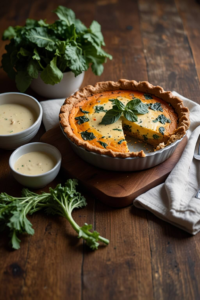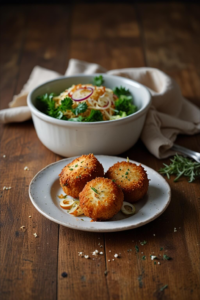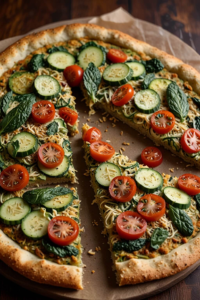Croquettes are versatile fried or baked food items usually made from a combination of ingredients such as chicken, potatoes, spices, and binders, all coated in breadcrumbs. They are extremely popular as appetizers due to their crispy texture and delightful flavors.
What are Croquettes?
Croquettes are small bread-crumb coated fried food rolls, often filled with a savory mixture. Principally, they contain ingredients like mashed potatoes or minced meat, which can be chicken, beef, or even fish.
Popularity as Appetizers
Besides their delicious taste, croquettes are a favored choice for appetizers at numerous gatherings. Their bite-size form makes them perfect for a party setting, allowing guests to mingle while enjoying these tasty morsels.
Key Ingredients
Chicken
Chicken is a preferred filling in croquettes due to its mild flavor and tender texture that pairs well with various spices and herbs.
Potatoes
Potatoes act as an excellent binder and base, giving croquettes their signature smooth interior and helping to maintain their shape during cooking.
Importance in Party Menus
Versatility
Whether serving a casual gathering or a formal event, croquettes can be adapted to fit the theme through the utilization of various ingredients and spices.
Guest Appeal
Most importantly, croquettes possess a high guest appeal factor; their crunchy exterior combined with a soft, flavorful inside can cater to various taste preferences, making them a surefire hit among party-goers.
Preparing the Ingredients
Boiling and Preparing Potatoes
Choosing the Right Type of Potatoes
For the best results, opting for starchy potatoes like Russets or Yukon Golds is crucial. These varieties ensure a fluffy and smooth texture inside the croquettes.
Cooking Techniques
To achieve the perfect consistency, it is essential to boil the potatoes until they are tender, followed by mashing them thoroughly to avoid lumps that could disrupt the texture of your croquettes.
Cooking and Shredding the Chicken
Best Chicken Cuts for Croquettes
The chicken breast, due to its low fat content and ease of preparation, is ideal for creating a fine, tender filling for croquettes.
Methods for Cooking Chicken
Boiling or steaming the chicken allows it to be easily shredded, which is perfect for mixing evenly with other ingredients, ensuring every bite is as good as the last.
Additional Ingredients
Spices and Herbs
Incorporating spices like paprika, black pepper, and herbs such as parsley or thyme can significantly enhance the flavor profile of your croquettes.
Binding Agents
Eggs and flour are essential binders that help maintain the shape of croquettes during the cooking process, ensuring they do not fall apart when fried or baked.
Mixing and Forming the Croquettes
Combining Ingredients
How to Ensure Even Mixing
It’s crucial to distribute the spices, chicken, and potato mixture uniformly. This consistency is key to achieving the perfect taste and texture in each croquette.
Tips for Flavorful Mix
Adding seasoning at different stages of mixing can profoundly influence the overall flavor, making them tasty and irresistible.
Shaping the Croquettes
Tools and Techniques
Using a small ice cream scoop or spoons can help achieve uniform size and shape, which is not only aesthetically pleasing but also ensures even cooking.
Size and Consistency Tips
Ensuring all croquettes are of similar size helps in cooking them evenly. Ideally, they should be small enough to eat in a couple of bites but large enough to encase the delicious filling.
Resting Before Cooking
Importance of Resting
Resting the shaped croquettes before cooking is critical as it allows the binders to set, minimizing the risk of them falling apart.
Time Duration and Conditions
Allow the croquettes to rest for at least 30 minutes in the refrigerator. This step not only helps in shaping but also enhances the flavors, melding them beautifully.
Cooking Techniques for Croquettes
Frying the Croquettes
Choosing the Right Oil and Temperature
When frying croquettes, selecting the appropriate oil is critical for achieving that desired golden crispness. Vegetable oils such as canola, peanut, or sunflower are excellent choices due to their high smoke points. This means they can handle the high temperature needed, which should be around 350°F to 375°F, ensuring your croquettes are perfectly crispy and not soggy.
Technique for Even Cooking
To ensure each croquette cooks evenly, it’s essential to master the turning technique. Use tongs to gently turn the croquettes every few minutes, achieving an even golden-brown color on all sides. Be cautious to avoid oil splatter by gently placing and turning the croquettes in the hot oil, which keeps your cooking environment safe and clean.
Baking Option
Healthier Alternative
For those seeking a healthier alternative, baking croquettes can be just as satisfying. Preheat your oven to 400°F and lightly grease a baking sheet. Place the croquettes on the sheet, ensuring they are not touching to allow air circulation for even cooking.
Achieving Crispiness in the Oven
To mimic the crunchiness typically achieved through frying, coat your croquettes with a light brushing of oil or a spray, and use breadcrumbs for added texture. Position them in the upper-middle part of the oven where heat is most consistent, turning halfway through baking.
Serving: Temperature and Texture
Best Temperature to Serve
Croquettes are best served hot. The ideal serving temperature is right after cooking when they’re most crispy. If they need to be warmed up, a quick stint in a hot oven for a few minutes can help revive their texture.
Maintaining Optimal Crispness
Serve the croquettes on a cooling rack over a sheet rather than directly on a plate lined with paper towels. This setup prevents steam from making the bottoms soggy, thereby maintaining that delightful crispness that makes croquettes irresistible.
Dips and Accompaniments
Selecting Complementary Dips
Popular Choices of Dips
When serving croquettes, offering a range of dips can enhance the eating experience. Popular options include creamy garlic aioli, spicy tomato salsa, or a classic tartar sauce. Experiment based on the croquette’s main ingredients; for instance, a mint-yogurt dip pairs wonderfully with lamb croquettes.
Homemade vs Store-Bought
While store-bought dips are convenient, homemade dips not only allow for customization but also avoid preservatives and excess sodium. A simple dip, such as combining sour cream with fresh herbs and a squeeze of lemon, can be prepared in minutes and often tastes fresher.
Side Dishes
Salads that Complement Croquettes
A light, refreshing salad balances the richness of croquettes. Consider a crisp green salad with vinaigrette or a tangy coleslaw. These sides add a delightful crunch and vibrancy to your dish.
Other Popular Sides
For a more filling option, roasted vegetables or a creamy mashed potato dish can serve as excellent companions to your croquettes.
Presentation Tips
Plating Techniques
Present your croquettes on a warm platter with dips and accompaniments artistically arranged. Allow for color contrasts and consider the convenience of your guests as they enjoy your dish.
Garnishes to Enhance Appearance
A sprinkle of finely chopped herbs, such as parsley or chives, not only adds a pop of color but also infuses aroma, enhancing the croquettes’ appeal and flavor.
Common Cooking Mistakes and Solutions
Overcrowding the Pan
Effects on Cooking
Overcrowding can lead to unevenly cooked croquettes with a greasier texture. It lowers the oil’s temperature, resulting in soggy, oil-logged appetizers.
How to Avoid
Cook in small batches, giving your croquettes enough room to fry uniformly. This attention to detail ensures each piece is crispy and cooked to perfection.
Under or Overcooking
Identifying Proper Doneness
Croquettes should be golden brown with a crisp outer shell and hot, moist interior. Cut one open to test for doneness before removing all from the heat source.
Adjusting Cooking Time and Temperature
If you find the croquettes browning too quickly on the outside but still raw inside, lower the heat slightly and extend the cooking time. Conversely, if cooking is too slow, slightly increase the temperature.
Lack of Flavor or Dryness
Seasoning Tips
Enhance flavor by ensuring your croquette mixture is well-seasoned before forming them. Taste and adjust as needed.
Moisture Retention Techniques
To avoid dryness, include ingredients like cooked onion or cheese, which not only add moisture but richness. Monitor cooking times closely as overcooking can dry out the fillings.
By combining these careful preparations and cooking techniques, you can serve up perfectly delicious and appealing croquettes every time.
Advanced Variations
Incorporating Different Types of Meat
Croquettes provide a versatile canvas for culinary experimentation where you can transform their flavor profile by merely alternating the type of meat. Considering fish or beef instead of the traditional chicken can infuse new flavors and textures into your croquettes. When using fish, lighter seasoning may enhance its natural flavors, while beef requires a robust mix of spices to complement its richness. Most importantly, remember to adjust the cooking times accordingly; fish typically cooks faster than beef.
Adding Vegetables and Cheeses
To bring a delightful twist to your croquettes, try incorporating a mix of cheeses and vegetables. Selecting vegetables that complement the main meat, such as spinach or mushrooms, can elevate the overall taste and add a nutritional boost. Moreover, choosing the right cheese—whether it’s a melty mozzarella or a sharp cheddar—can significantly enhance the flavor profile. Remember, the inclusion of these ingredients should balance with the main meat to maintain harmony in taste.
Spice-Level Adjustments
The flexibility of croquettes allows you to cater to various taste preferences, from mild to spicy. Adapting the spice level can completely change the dining experience. For those preferring milder flavors, herbs such as parsley or tarragon may suffice. However, for a spicier kick, incorporating elements like cayenne pepper or finely chopped jalapeños can be thrilling. It’s vital to balance these flavors to ensure that the spice enhances rather than overwhelms the croquettes.
Tips for Large-Batch Preparation
Scaling Ingredients
When preparing croquettes for a large gathering, the key to success lies in accurately scaling your ingredients. Efficiency is crucial, and simple math and precise measuring can ensure consistency in flavor and texture. Besides that, paying attention to proportions helps maintain the delicacy’s quality across the batch.
Equipment and Workflow Optimization
Large-scale preparations can be streamlined using industrial kitchen tools. Deploying an organized cooking process can significantly enhance efficiency. Industrial mixers, large-scale ovens, or deep fryers can handle bigger batches effectively, ensuring every croquette is perfectly cooked.
Storing and Reheating
Proper storage and reheating methods are crucial for retaining the freshness and texture of croquettes. The best practices include cooling them quickly and storing them in air-tight containers to prevent moisture loss. When reheating, using an oven rather than a microwave can help preserve the crispiness, ensuring they remain just as delicious as when first made.
Engaging Your Guests with Interactive Serving Options
DIY Croquette Bar
A DIY croquette bar not only adds an element of fun to your gathering but also allows guests to customize their appetizers. Set up a variety of ingredients, including different meats, vegetables, cheeses, and sauces. Providing a selection of toppings and letting guests choose their combinations can make for an engaging culinary experience.
Pairing with Beverages
Select beverages that complement the flavors of croquettes. A full-bodied red wine or a crisp beer can enhance the dining experience. For those who prefer non-alcoholic options, consider rich, aromatic coffees or refreshing mocktails that echo the spices used in the croquettes.
Fun Facts and Conversation Starters
While enjoying their customized croquettes, entertain your guests with intriguing anecdotes about the history of croquettes and their global variations. Discussing related culinary topics can spark engaging conversations and make the meal memorable.
These advanced tips and engaging serving suggestions can elevate the humble croquette from a simple appetizer to the star of your culinary event, ensuring your guests leave not just satiated, but impressed.




